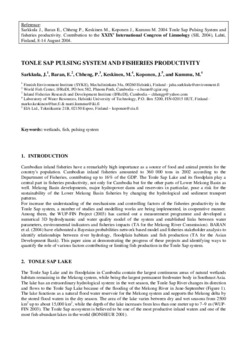Tonle Sap pulsing system and fisheries productivity
Abstract
Cambodian inland fisheries have a remarkably high importance as a source of food and animal protein for the country's population. Cambodian inland fisheries amounted to 360 000 tons in 2002 according to the Department of Fisheries, contributing up to 16% of the GDP. The Tonle Sap Lake and its floodplain play a central part in fisheries productivity, not only for Cambodia but for the other parts of Lower Mekong Basin as well. Mekong Basin developments, major hydropower dams and reservoirs in particular, pose a risk for the sustainability of the Lower Mekong Basin fisheries by changing the hydrological and sediment transport patterns. For increase the understanding of the mechanisms and controlling factors of the fisheries productivity in the Tonle Sap system, a number of studies and modelling works are being implemented, in cooperative manner. Among them, the WUP-FIN Project (2003) has carried out a measurement programme and developed a numerical 3D hydrodynamic and water quality model of the system and established links between water parameters, environmental indicators and fisheries impacts (TA for the Mekong River Commission). BARAN et al. (2004) have elaborated a Bayesian probabilities network based model and fisheries stakeholder analysis to identify relationships between river hydrology, floodplain habitats and fish production (TA for the Asian Development Bank). This paper aims at demonstrating the progress of these projects and identifying ways to quantify the role of various factors contributing or limiting fish production in the Tonle Sap system

